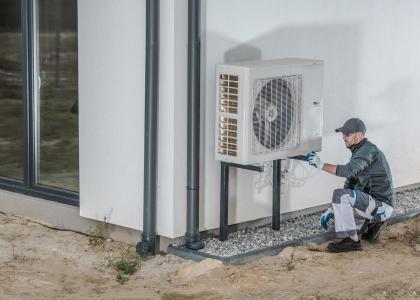2022 was a very good year for energy efficiency, and in 2023 we can build on last year’s successes to accomplish even more. Accomplishments and opportunities include the Inflation Reduction Act (IRA); growing momentum on decarbonization strategies; stronger appliance, vehicle, and building performance standards; and increased attention to addressing underserved communities. Just IRA is projected to reduce U.S. greenhouse gas emissions in 2030 by about 5–8%, with the other building blocks contributing even more.
Implementing the Inflation Reduction Act
The IRA, adopted by Congress this past summer, contains more than $300 billion in clean energy investments, including tens of billions for energy efficiency. Among its many provisions, IRA updates and expands a variety of energy efficiency and clean vehicle tax credits, funds new state rebate programs for home efficiency upgrades and electrification, invests in advanced industrial process technologies, funds efforts by federal agencies to lead by example in buying low-carbon materials, and establishes a national fund for green banks and other financial and technical assistance to reduce greenhouse gas emissions.
In 2023, numerous federal agencies will need to make decisions on rules for the many new programs, and then states, localities, and other partners will need to develop and begin implementing programs. Some tax guidance is already out, but recent indications are that other federal rules and guidance will start emerging in the spring and that many programs will begin in the fall. In some cases, IRA prescribes rebate amounts and who is eligible; agencies can’t change these specifics. These rebates will provide an important framework that local programs can build on. For these programs to be most successful, utilities, states, and other partners can complement and fill in gaps in and around the federal programs.
Other notable legislation in 2022 includes the CHIPS Act, which invests in increased U.S. production of computer chips, such as those needed in many energy-saving technologies, and in building essential sciences capacity. The $1.7 trillion year-end appropriations legislation increases funding for some energy efficiency programs. Though 2022 was a very good year for federal legislation, we are likely to see much less legislation in 2023 due to split control of Congress, differences of opinion within the Republican and Democratic caucuses, and the beginnings of the 2024 election campaign.
Decarbonization strategies for transportation, utilities, and industry
In 2022, growing numbers of states and cities developed decarbonization strategies to help meet their climate goals. Several states (California, Massachusetts, Oregon, Vermont, and Washington) adopted goals and regulations to limit new passenger vehicle sales to zero-emission vehicles, typically by 2035. Growing numbers of utilities have committed to net zero-emissions, including multiple dual-fuel utilities and several gas-only utilities (such as Northwest Natural and Southern California Gas).
Colorado regulators issued rules to implement a clean heat standard, and the Vermont legislature passed (but the governor vetoed) a clean heat standard. Clean heat standards are requirements that gas utilities and sometimes other fuel suppliers steadily reduce carbon emissions from heating through a mix of strategies including energy efficiency, leak reduction, electrification, and use of decarbonized fuels. Oregon’s governor established a somewhat similar Climate Protection Program via executive order. The U.S. Department of Energy (DOE) issued an industrial decarbonization roadmap, growing numbers of industrial firms are committing to decarbonization, and an increasing number of states are focusing on industrial decarbonization (including California, Massachusetts, Michigan, New York, Oregon, and Washington).
In 2023, this momentum is likely to increase, with more states adopting zero-emission vehicle and clean heat standards. The Vermont legislation will be reconsidered, New York’s governor has proposed a zero-emission vehicle goal, and the just-completed Massachusetts climate plan proposed a clean heat standard. And more industry leaders are likely to embrace decarbonization strategies. For example, the Portland Cement Association (a trade organization for cement companies) has advanced a decarbonization strategy for its industry, and global support for decarbonizing steel is growing.
Setting new standards
In December, the Biden administration finalized a standard limiting health-harming air pollutants from heavy-duty vehicles. DOE finalized efficiency standards for light bulbs and proposed standards for residential furnaces, clothes dryers, electricity distribution transformers, and other products. Legislation establishing building performance standards was enacted in Montgomery County, Maryland. Maryland adopted a statewide building performance standard. And a performance standard for federal buildings was adopted by the Biden administration. New state equipment or clean lighting standard laws were enacted in California, Maryland, New York, and Vermont.
These trends will likely continue in 2023. Federal agencies are scheduled to propose new fuel economy and greenhouse gas emissions standards for heavy vehicles and are beginning work on the next round of standards for passenger vehicles. The Biden administration plans to issue 30 proposed and final appliance efficiency standards, including for furnaces, water heaters, refrigerators, and clothes washers. City councils in Seattle; Portland, Oregon; and Cambridge, Massachusetts, plan to adopt building performance standards this year. More than 20 additional jurisdictions have pledged to adopt such standards as part of their participation in the Building Performance Standards Coalition.
Addressing underserved communities
In the past few years, many states, municipalities, and utilities have devoted more attention toward better serving low-income communities as well as Black, Hispanic and other communities of color. The IRA included an unprecedented focus on these communities. A 2022 ACEEE report found that in 2019, across more than 90 utilities, more than $900 million was invested in low-income energy efficiency programs, up substantially from 2015. Still, the report found that for the companies providing spending data, the median electric and gas utility spending on low-income programs was about 13% of total energy efficiency program budgets, substantially less than the approximately 27.5% of the U.S. population who are income-qualified for these programs.
In 2023, programs serving low-income households are likely to continue to grow and increasingly provide whole-home services, not just low-cost measures. We foresee growing pressure from community and other groups (including ACEEE) to devote a higher share of energy efficiency budgets to serving low-income communities. And as funding from the IRA-funded Environmental and Climate Justice Block Grants and the Greenhouse Gas Reduction Fund starts to flow, benefits will come to these communities due both to the federal funding and to the local and private funding that these federal programs will help leverage.
Urgent work ahead
2023 is likely to be an exciting year for energy efficiency, building on the many accomplishments of 2022. Given high energy costs this winter and the critical role of energy efficiency in reducing greenhouse gas emissions to curb climate change, continued energy efficiency progress this year will be essential.




